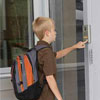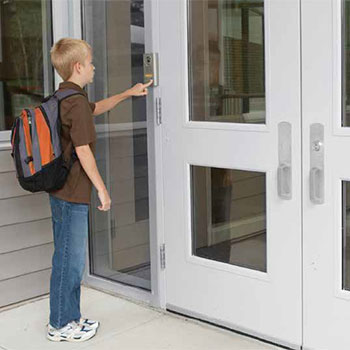
Security on a Budget
A good place to start is the front door of any campus facility
- By Patrick V. Fiel Sr.
- Jul 01, 2014
 There’s an old axiom that a good salesman
could sell virtually anything to anybody—even
if the item isn’t always the best fit for a need.
Unfortunately, school administrators can be
victims of a good, but deceptive sales pitch.
Often, K-12 school districts purchase expensive
security components designed to protect students,
staff and property. This equipment is
likely high quality and serves a legitimate purpose,
but does it really meet the district’s overall
needs? Does it integrate with other equipment
already in place? Or, could security needs
be met while spending less?
There’s an old axiom that a good salesman
could sell virtually anything to anybody—even
if the item isn’t always the best fit for a need.
Unfortunately, school administrators can be
victims of a good, but deceptive sales pitch.
Often, K-12 school districts purchase expensive
security components designed to protect students,
staff and property. This equipment is
likely high quality and serves a legitimate purpose,
but does it really meet the district’s overall
needs? Does it integrate with other equipment
already in place? Or, could security needs
be met while spending less?
Through careful planning and following a checklist, it is possible for
schools to develop a quality security plan that meets campus needs
without breaking the budget. Any new or upgraded security plan
should begin with a risk assessment performed by experienced, independent
security professionals, who will work closely with school
administrators and local law enforcement to complete the process.
Assessment results serve as the initial step in developing an action plan for each campus. Assessments should begin with the surrounding
neighborhood as businesses, parks and traffic patterns can impact a
school. Student passages to and from school, landscaping, parking lots,
athletic fields, outbuildings and communications systems should also
be included in the plan. An assessor should then move on to one of the
most critical points on campus—the main public entry.
Securing the Entry
For too many K-12 campuses, the front door provides open and easy
access for parents, volunteers and vendors but also for registered sex
offenders, thieves, vandals and even active shooters. By controlling this
entry and locking all others, school administrators can go a long way
toward protecting their campus.
The goal is to provide layers of security, each contributing to keeping
unwanted visitors away from students. Crime Prevention Through
Environmental Design (CPTED) requires that the front entry is free
from trees and bushes that could serve as a hiding place for people
looking to piggyback into the school with other visitors or hide weapons
and other contraband. Also, make sure lighting is bright enough to
identify anyone trying to enter on a dark afternoon.
Here is a look at the basic equipment that can be purchased and
installed at a reasonable cost to provide layers of security to protect
one of a campus’ most vulnerable points.
Signage. Have signs in the parking lot and around the perimeter
making it clear—in multiple languages, if necessary—that all visitors
must use the main entry to access the school building.
Remote-controlled locks. Keep the front door locked at all times
while providing a receptionist or other front office workers the ability
to remotely open the door with the push of a button.
Video intercoms. Consider these to be a school’s video doorbell. A
video intercom lets an office worker see and talk with a person who is
requesting access before unlocking the door. If the person has a legitimate
reason to enter, the lock is opened; however, should there be any
doubts, the door stays locked.
Signage should clearly explain the process for using the intercom.
Security screens. Glass doors at many schools still leave locked
entries vulnerable. The shooter at Sandy Hook elementary, for example,
shot his way through a glass panel next to the locked front entrance
doors of the school to gain entry. Stainless steel mesh security screens
can make any glass in doors or windows virtually impervious to gunshots
or knives.
Entry vestibule. Once inside the main entry, visitors still should not
be cleared to enter campus areas such as classrooms, cafeterias, libraries
and auditoriums. A vestibule should open into the office for the
next step in the entry process. In many schools this may require the
building of a wall and an extra locked door.
Visitor management. For years, schools have simply asked visitors
to sign in upon entering the campus, and too many schools are
still using this method. Instead, once a person arrives in the office,
he or she should be asked to present a government-issued ID to
swipe through a visitor management system. In seconds, the system
should check the card’s information against federal and state databases
for registered sex offenders. The system also can check locallyentered
data to identify non-custodial parents or former disgruntled
school employees.
When a visitor is approved, the system prints a temporary photo ID
badge to be worn throughout the campus visit. At this point, a visitor
can be cleared to enter the rest of the campus with the remote unlocking
of the vestibule door.
There are also a couple of add-on pieces of equipment that can further
enhance security at the entry:
Panic button. A discreet button under a receptionist’s desk, tied to
a school’s access, intercom or intrusion system, can immediately notify
first responders of an emergency situation on campus.
Video surveillance. Cameras mounted just inside the entry can
help guard against piggybacking at the front door. Another camera
placed in the office will provide another view of visitors as they check
in at the front desk.
Keeping the Rest of the Campus Secure
Most of the solutions for protecting the entry will have applications
throughout the school.
- All other exterior doors should be kept locked. Assign only one
as the entry for faculty and staff. A keypad or a cardkey system
will allow them access while also providing an audit trail of who
has entered.
- Make sure all classrooms are lockable from the inside, and keep
them locked when children are present. Add a $10 peephole so the
teacher can see who wants entry without having to open the door.
- Lock the loading docks where supplies are delivered throughout the
day. By adding a second video intercom, office personnel can allow
known vendors access for deliveries.
- Cameras placed in key hallways, the cafeteria and around all exterior
entries provide valuable, real-time, forensic information. This
allows emergency responders to view the situation live to take
appropriate action.
- Consider doing background checks of your volunteers and vendors.
There are a number of services that now make this an affordable
option while adding yet one more layer of protection to campus
security. (Did you know that there are over 700,000 registered sex
offenders in the United States?)
Policies and Procedures
Don’t spend the money to secure a campus without the proper policies
and procedures to make sure the equipment is being properly used.
Train several people on the use of the video intercom system. Although
its operation is simple, you want to make sure the operator asks the
right questions of would-be visitors before allowing them access.
Instruct all faculty and staff members to challenge anyone in the
school building that is not wearing a permanent or temporary badge.
Impress upon all staff members—even students—the dangers of propping
open a door. It’s an open invitation for would-be criminals.
Also, budget funding to maintain the various systems and keep
them running as intended.
When it comes to protecting students, you want to put as many layers
as possible between the public and all classrooms. Concentrate on
what has been proven to work while being aware of slick sales pitches.
Salespeople can make any product sound like a vital piece of any security
plan when, in fact, it may not be appropriate or is more than what
is necessary. It all starts with securing and limiting front entry options
and then tightening down on the front door.
The solutions outlined here are generally affordable
for most schools and districts, and are valid
for virtually all schools no matter age, design or
type of construction.
This article originally appeared in the July 2014 issue of Security Today.